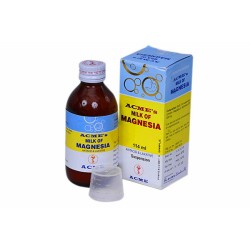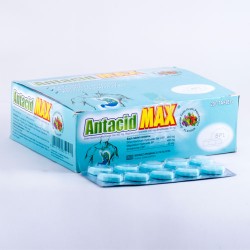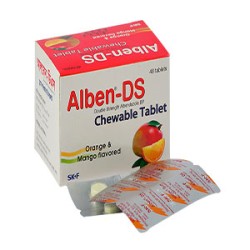Losectil 40mg/vial IV injection 1's pack

Losectil 40mg/vial IV injection 1's pack
৳ 70.00/=
Ex Tax: ৳ 70.00/=
- Stock: In Stock
- Model: MEDI-00102
- Generic: Omepraole IV
- Pack Size: Each pack contains 1 IV injection of Losectil 40mg/vial
0 items sold
4679 views
Available Options
Indications
Omeprazole offers significant therapeutic gains in the treatment of acid related diseases. Healing rates are high in duodenal ulcer, gastric ulcer and erosive reflux oesophagitis; acid production is controlled effectively in Zollinger-Ellison Syndrome and symptom relief is prompt and sustained in all indications. Less clear-cut indications where benefit might be expected but where data are limited include:
- Prevention of stress ulceration
- Prevention of the acid aspiration syndrome
- Treatment of upper gastro-intestinal bleeding
Therapeutic Class
Proton Pump Inhibitor
Pharmacology
Omeprazole belongs to a class of antisecretory compounds, the substituted benzimidazoles, that suppress gastric acid secretion by specific inhibition of the H+/K+ ATPase enzyme system at the secretory surface of the gastric parietal cell. Because this enzyme system is regarded as the acid (proton) pump within the gastric mucosa, omeprazole has been characterized as a gastric acid-pump inhibitor, in that it blocks the final step of acid production. This effect is dose-related and leads to inhibition of both basal and stimulated acid secretion irrespective of the stimulus.
Dosage
Oral-
Duodenal Ulcer: 20 mg once daily for 4 weeks. In severe cases, 40 mg once daily for 4 weeks.Gastric Ulcer: 20 mg once daily for 8 weeks. In severe cases, 40 mg once daily for 8 weeks.
Erosive Reflux Oesophagitis: 20 mg once daily for 4 weeks. For those not fully healed, to be continued for 4 more weeks. Refractory Reflux Oesophagitis: 40 mg once daily for 8 weeks. Zollinger-Ellison Syndrome: 60 mg once daily, adjusted individually and continued as long as necessary.
Most patients will be effectively controlled with 20-120 mg daily. Dosage above 80 mg should be divided and given twice daily. Long-term maintenance treatment with Omeprazole is not recommended.
Impaired Renal or Hepatic Function: Adjustment is not required. Patients with severe liver disease should not require more than 20 mg Omeprazole daily
IV Injection-
Prophylaxis of acid aspiration: Omeprazole 40 mg to be given slowly (over a period of 5 minutes) as an intravenous injection, one hour before surgery.Duodenal ulcer, gastric ulcer or reflux oesophagitis: In patients with duodenal ulcer, gastric ulcer or reflux oesophagitis where oral medication is inappropriate, Omeprazole IV 40 mg once daily is recommended.
Zollinger- Ellison syndrome (ZES): In patients with Zollinger-Ellison Syndrome the recommended initial dose of Omeprazole given intravenously is 60 mg daily. Higher daily doses may be required and the dose should be adjusted individually. When doses exceed 60 mg daily, the dose should be divided & given twice daily.
Administration
Powder for suspension: Should be taken on an empty stomach. Take at least 1 hr before a meal.
Capsule or Tablet: Should be taken with food. Take immediately before a meal. Patients should be cautioned that the capsules should not be opened, chewed or crushed and should be swallowed whole.
Delayed release Capsule or Tablet: Should be taken on an empty stomach. Take at least 1 hr before meals. Swallow whole, do not chewithcrush. For patients with difficulty swallowing, cap may be carefully opened & entire contents sprinkled in a spoonful of applesauce. Swallow drug/food mixt witho chewing immediately after prep. Drug/food mixt should not be stored for future use.
IV Injection: Omeprazole lyophilized powder and water for injection is for intravenous administration only and must not be given by any other route. Omeprazole IV injection should be given as a slow intravenous injection. The solution for IV injection is obtained by adding 10 ml water for injection to the vial containing powder. After reconstitution the injection should be given slowly over a period of at least 2 to 5 minutes at a maximum rate of 4 ml/minute. Use only freshly prepared solution. The solution should be used within 4 hours of reconstitution.
IV Infusion: Omeprazole IV infusion should be given as an intravenous infusion over a period of 20-30 minutes or more. The contents of one vial must be dissolved in 100 ml saline for infusion or 100 ml 5% Dextrose for infusion. The solution should be used within 12 hours when Omeprazole is dissolved in saline and within 6 hours when dissolved in 5% Dextrose. The reconstituted solution should not be mixed or co-administered in the same infusion set with any other drug.
Capsule or Tablet: Should be taken with food. Take immediately before a meal. Patients should be cautioned that the capsules should not be opened, chewed or crushed and should be swallowed whole.
Delayed release Capsule or Tablet: Should be taken on an empty stomach. Take at least 1 hr before meals. Swallow whole, do not chewithcrush. For patients with difficulty swallowing, cap may be carefully opened & entire contents sprinkled in a spoonful of applesauce. Swallow drug/food mixt witho chewing immediately after prep. Drug/food mixt should not be stored for future use.
IV Injection: Omeprazole lyophilized powder and water for injection is for intravenous administration only and must not be given by any other route. Omeprazole IV injection should be given as a slow intravenous injection. The solution for IV injection is obtained by adding 10 ml water for injection to the vial containing powder. After reconstitution the injection should be given slowly over a period of at least 2 to 5 minutes at a maximum rate of 4 ml/minute. Use only freshly prepared solution. The solution should be used within 4 hours of reconstitution.
IV Infusion: Omeprazole IV infusion should be given as an intravenous infusion over a period of 20-30 minutes or more. The contents of one vial must be dissolved in 100 ml saline for infusion or 100 ml 5% Dextrose for infusion. The solution should be used within 12 hours when Omeprazole is dissolved in saline and within 6 hours when dissolved in 5% Dextrose. The reconstituted solution should not be mixed or co-administered in the same infusion set with any other drug.
Interaction
Omeprazole can delay the elimination of Diazepam, Phenytoin and Warfarin. Monitoring of patients receiving Warfarin or Phenytoin is recommended and a reduction of Warfarin or Phenytoin dose may be necessary when Omeprazole is added to treatment. Omeprazole does not interfere with Theophylline or Propranolol metabolism.
Contraindications
Omeprazole is contraindicated in patients with known hypersensitivity to any component of the formulation.
Side Effects
Side effects reported with Omeprazole in clinical studies have included nausea, diarrhoea, constipation, flatulence, abdominal colic, paresthesia, dizziness and headache but are rare. Skin rashes, leukopenia and transient elevation of plasma activation of hepatic amino-transferases have been observed occasionally in few patients and there has been no consistent relationship with treatment.
Pregnancy & Lactation
Pregnancy: There are no adequate and well-controlled studies on the use of Omeprazole in pregnant women. Therapeutic doses during pregnancy are unlikely to pose a substantial teratogenic risk. Omeprazole should be used during pregnancy only if the potential benefit to pregnant women justifies the potential risk to the fetus.
Lactation: Omeprazole is excreted in human milk. Thus, a decision should be taken to discontinue nursing or to discontinue the drug, taking into account the importance of the drug to the mother.
Lactation: Omeprazole is excreted in human milk. Thus, a decision should be taken to discontinue nursing or to discontinue the drug, taking into account the importance of the drug to the mother.
Precautions
Precautions: Symptomatic response to therapy with Omeprazole does not preclude the presence of gastric malignancy.
Warning: In long-term (2 years) studies in rats, Omeprazole produced a dose related increase in gastric carcinoid tumours. While available endoscopic evaluations and histologic examinations of biopsy specimens from human stomachs have not detected a risk from short-term exposure to Omeprazole, further human data on the effects of sustained hypochlorhydria and hypergastrinemia are needed to rule out the possibility of an increased risk for the development of tumours in humans receiving long-term therapy with Omeprazole.
Warning: In long-term (2 years) studies in rats, Omeprazole produced a dose related increase in gastric carcinoid tumours. While available endoscopic evaluations and histologic examinations of biopsy specimens from human stomachs have not detected a risk from short-term exposure to Omeprazole, further human data on the effects of sustained hypochlorhydria and hypergastrinemia are needed to rule out the possibility of an increased risk for the development of tumours in humans receiving long-term therapy with Omeprazole.
Overdose Effects
Symptoms were transient, and no serious clinical outcome has been reported with Omeprazole overdose. No specific antidote for Omeprazole overdose is known. Omeprazole is extensively bound with protein and is, therefore, not readily dialyzable. In the event of overdose, treatment should be symptomatic and supportive.
Use in Special Population
Renal Impairment: No dosage adjustment needed
Hepatic Impairment: 10-20 mg/day
Pediatric Use: Safety and effectiveness in children have not been established
Hepatic Impairment: 10-20 mg/day
Pediatric Use: Safety and effectiveness in children have not been established
Storage Conditions
Store in a cool and dry place. Keep out of the reach of children.
Source: medex.com.bd
Tags:
Gastro-Intestinal
, General medicine
, OTC
, Peptic Ulcer
, Gastric Ulcer
, Reflux Oesophagitis
, Heart burn
, Acidity
, Gas
, Emergency
, Hospital














